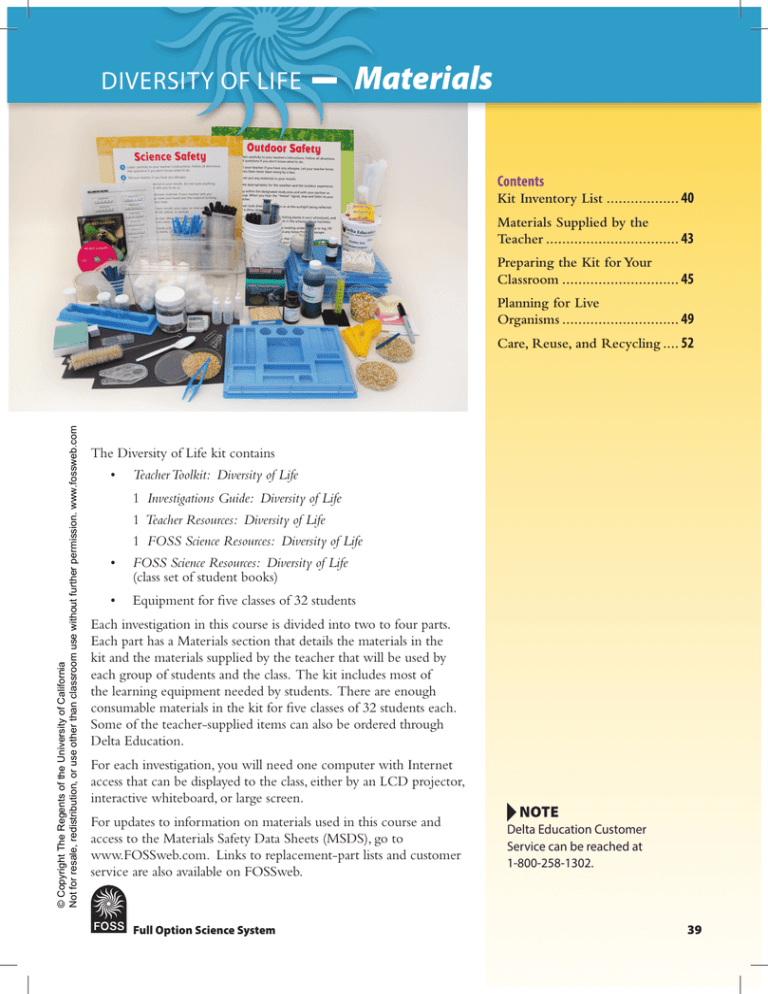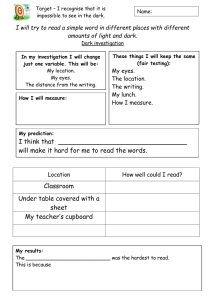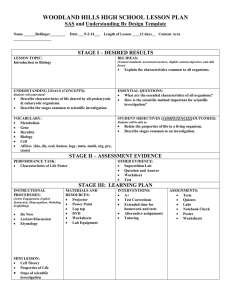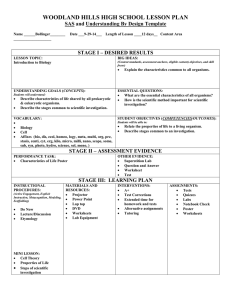Materials
advertisement

w – – diversity ofMatter life Materials Measuring Materials Contents Kit Inventory List................... 40 Materials Supplied by the Teacher.................................. 43 Preparing the Kit for Your Classroom.............................. 45 Planning for Live Organisms.............................. 49 © Copyright The Regents of the University of California Not for resale, redistribution, or use other than classroom use without further permission. www.fossweb.com Care, Reuse, and Recycling..... 52 The Diversity of Life kit contains • Teacher Toolkit: Diversity of Life 1 Investigations Guide: Diversity of Life 1 Teacher Resources: Diversity of Life 1 FOSS Science Resources: Diversity of Life • FOSS Science Resources: Diversity of Life (class set of student books) • Equipment for five classes of 32 students Each investigation in this course is divided into two to four parts. Each part has a Materials section that details the materials in the kit and the materials supplied by the teacher that will be used by each group of students and the class. The kit includes most of the learning equipment needed by students. There are enough consumable materials in the kit for five classes of 32 students each. Some of the teacher-supplied items can also be ordered through Delta Education. For each investigation, you will need one computer with Internet access that can be displayed to the class, either by an LCD projector, interactive whiteboard, or large screen. For updates to information on materials used in this course and access to the Materials Safety Data Sheets (MSDS), go to www.FOSSweb.com. Links to replacement-part lists and customer service are also available on FOSSweb. Full Option Science System NOTE Delta Education Customer Service can be reached at 1-800-258-1302. 39 – Materials diversity of life Kit inventory List Drawer 1—permanent equipment Equipment condition 1 Teacher Toolkit: Diversity of Life (1 Investigations Guide, 1 Teacher Resources, and 1 FOSS Science Resources: Diversity of Life) 32 FOSS Science Resources: Diversity of Life, student books * 1 Brine shrimp eggs, vial ✪ 1 Camphor crystal block, in plastic jar 1 Card set, Living/Nonliving, 32 large cards/set 16 Card sets, Living/Nonliving, 31 cards/set 16 Card sets, Levels of Complexity, 21 cards/set 1 Congo red stain, bottle, 10 g/bottle ✪ 4 Containers, 1 L 32 Cup lids, plastic, 250 mL 50 Cups, plastic, 250 mL 1 Food coloring, bottle, red, 30 mL (1 oz.) ✪ 840 Labels, removable, 1 × 4.5 cm 9 Marking pens, permanent 24Minispoons 1 Polyacrylate crystals, package, 58 g/pkg ✪ 1Poster, Outdoor Safety 1Poster, Science Safety 1 Salt, kosher crystals, container, 310 g/container ✪ 1 Sand, red, bag ✪ 1 String, 30 m/ball ✪ 2 Transparency sheets, millimeter rulers, 18/sheet 1Video, The Secret Garden 48 Zip bags, small, 7 × 12 cm * The student books are shipped separately in two boxes of 16 hardbound books each. Drawer 1—consumable equipment Paper 200 ✪ These items might occasionally need replacement. 40 1 1 1 4 1 clips, jumbo Tape, transparent packing, 5 cm wide, roll Index cards, unlined, 12.7 × 20.3 cm (5" × 8") package, 100/package Seeds, barley, package, 28.3 g (1 oz.)/package Seeds, corn, package, 31.9 g (1 1/8 oz.)/package Seeds, oats, package, 56.7 g (2 oz.)/package Full Option Science System Equipment condition 3 Seeds, radish, package, 15 g (1/2 oz.)/package 1 Seeds, wheat, package, 1/8 c./package 6 Yeast, package, 7 g (1/4 oz.)/package Drawer 2—permanent equipment 8 1 1 24 32 16 8 32 1 1 1 100 72 100 8 24 1 12 1 32 Basins, clear, plastic, with lids, 6 L Bottle brush Cotton balls, bag, 100/bag ✪ Droppers, plastic Dropper bottles, plastic, 15 mL Forceps, plastic Graduated cylinders, plastic, 50 mL Hand lenses Lens paper, 7.5 × 10 cm, package, 50 sheets/package ✪ Methyl cellulose, 1.5%, bottle, 100 mL/bottle ✪ Methylene blue stain, 0.1%, bottle, 250 mL/bottle ✪ Microscope slide coverslips, plastic, box ✪ Microscope slides, glass Microscope slide coverslips, plastic, box ✪ Microscope tool kit trays Spoons, plastic Spoon set, metric Syringes, 35 mL Toothpicks, flat, box, 750/box ✪ Zip bags, 4 L ✪ These items might occasionally need replacement. Diversity of Life Course, Second Edition 41 – Materials diversity of life Drawer 3—permanent equipment Equipment Condition 41 Vial holders, plastic, blue 300 Vials, with caps, 12 dram Drawer 4—permanent equipment 40 Bags, plastic, 36 × 51 cm (14" × 20") 160 Petri dishes, 100 × 15 mm Drawer 4—consumable equipment 50 Petri dishes, 100 × 15 mm Drawer 5—permanent equipment 48 Containers, plastic, with lids 1/2 L Drawer 5—consumable equipment 160 500 600 10 500 5 50 Construction paper sheets, dark Cotton swabs Index cards, 7 × 12.5 cm (3" × 5") Nutrient agar, bottle, 125 mL/bottle Self-stick notes, 7.5 × 7.5 cm (3" × 3") Self-stick notes, small Zip bags, 1 L NOTE: These quantities and drawer configurations are for the 5-class kit. If you purchased a 1-class kit, the materials shown here in Drawers 3-5 are in your Drawer 3, at reduced quantities. ✪ These items might occasionally need replacement. 42 Full Option Science System Materials Supplied by the Teacher Each part of each investigation has a Materials section that describes the materials required for that part. It lists materials needed for each student or group of students and for the class. Be aware that you must supply some items. These are indicated in the materials list for each part of the investigation with an asterisk (*). Here is a summary list of those items. Some of the supplies and tools are available from Delta Education. Check the replacement-part list for the course on FOSSweb. Technology equipment • Computers with Internet access 1 Document camera or overhead projector 1 Projection system • Extension cords with multiple outlets (optional) Measuring tools 1–2 Balances, electronic, accurate to 0.1 g 1 Beaker, 1 L 3 Beakers, 500 mL (optional) 1 Graduated cylinder, 50 mL 8 Rulers 1 Thermometer, Celsius Paper •Cardboard • Chart paper • Index cards, (optional) • Magazine photographs, colored •Newspaper • Notebook paper • Paper towels • Paper towels, extra absorbent • Science notebooks (composition books) • Scratch paper • White paper, 22 ✕ 56 cm (8.5" ✕ 11") Resources • Field guides, insects • Field guides, plants Diversity of Life Course, Second Edition 43 – Materials diversity of life Supplies Safety NOTE This course uses seeds and foods. Be sure to check for student allergies to these items. 44 •Bleach • Bread slices with no preservatives• • Bucket (optional) • Celery stalks with leaves • Dry leaves, grass, soil •Flowers • Alstroemeria and/or gladiolus • Mixed bouquet • Food for cockroaches (apple, banana, bread, potato chip, etc.) • Food samples • Blue cheese or other “mold” cheese •Bread • Grain-based foods (optional) •Mushrooms • Swiss cheese • Sauerkraut or kimchi • Yogurt, plain • Gloves, rubber (optional) • Glue sticks (optional) • Honey or syrup • Lima beans, bag • Masking tape • Mushrooms, button • Painter’s tape (optional) • Paper plates, muffin cups, or waxed paper • Pet food, dry 1 Petroleum jelly, jar • Plastic spoons, small • Potting soil, 1 L (optional) • Rubbing alcohol • Sheet protectors, clear-plastic 8Straws •Sugar • Transparent tape • Water, bottled spring or drinking Full Option Science System Other tools • Bottle, plastic, 1.5 L 16Calculators 8 Cameras (optional) 8 Clipboards (optional) • Colored pencils, marking pens, and highlighters 8 Containers, empty, yogurt 1 Flashlight, large 1 Flowerpot, planter, or cup with hole (optional) 1 Heat source, such as a hot plate 1 Hobby knife 1 Knife, sharp, or single-edged razor blade 8Mini-whiteboards 8 Marking pens, whiteboard (optional) 16 Microscopes, 40X–400X 2 Microscopes, dissecting, 10X–30X (optional) 1 Net, sweep (optional) 1 Pan, small 1 Oven mitt 1Pitcher 32 Safety goggles 32Scissors 16 Slides, prepared, human-cheek tissue (optional) 1 Spray mister 2Trays 1Tub 1 Whistle (optional) TEACHING NOTE In Investigation 3, Part 4, students will observe their own cheek cells. If your district restricts examination of human tissue, acquire prepared slides from a commercial supply house. Live organisms 8 16 • • • 1 Elodea sprigs Madagascar hissing cockroaches Paramecium caudatum culture Plant cuttings Protist cultures (optional) Tradescantia zebrina (spiderwort) plant Diversity of Life Course, Second Edition 45 – Materials diversity of life Preparing the Kit for Your Classroom Some preparation is required each time you use the kit. Doing things before beginning the course will make daily setup quicker and easier. Each part of each investigation includes a section called Getting Ready, which describes what you need to do or consider to be prepared to conduct the part. Note that a few items are consumable, but there should be enough in the kit for at least five classes before you need to restock. Science Notebooks You will need to make copies of science notebook sheets before each investigation. See Getting Ready for Investigation 1, Part 1, for ways to organize the science notebook sheets for this course. If you use a projection system, you can download electronic copies of the sheets from FOSSweb. One-Time Preparation Some of the preparation will need to be done only once. Here are things that require one-time preparation. Investigation 1, Part 1 Prepare Living/Nonliving card sets. Prepare the set of Living/ Nonliving large cards. Investigation 1, Part 2 Prepare unknown materials in zip bags. Investigation 2, Part 1 Prepare microscope kits. Cut out millimeter rulers from transparencies. Fill 16 dropper bottles with water. Investigation 3, Part 2 Prepare methyl cellulose slowing medium and put into eight dropper bottles. Investigation 3, Part 4 Prepare eight dropper bottles of methylene blue stain. Investigation 4, Part 1 Prepare Levels of Complexity card sets. 46 Full Option Science System Investigation 4, Part 2 Make a one-million-dots poster. Investigation 5, Part 2 Purchase a Tradescantia zebrina plant for stomata research. Investigation 7, Part 1 Purchase Madagascar hissing cockroaches. Obtain a large glass aquarium and prepare to maintain a colony as directed in Investigation 7 or in this chapter. Investigation 8, Part 1 Prepare a plant-collection grid. Review Safety Guidelines There are safety posters in the kit. Consider how to introduce the class rules so that everyone has a safe science experience. Provide safety goggles for activities where students are using camphor, congo red stain, polyacrylate crystals, kosher salt, and methylene blue stain. You will see a warning label on several student notebook sheets. The label is required by the US Consumer Product Safety Commission (CPSC) whenever students work with chemicals. The label should act as a reminder to you and students to exercise safety precautions when working with materials in the investigation where the sheet is used. In these investigations, salt requires this safety labeling. Reserve Computer Lab In Investigation 7, students should have access to computers in pairs or individually. In Investigations 4 and 6, student access is optional. Plan ahead to use multiple computers at this time. Consider Outdoor Observations Students go outdoors in Investigation 1 to collect materials for a minihabitat. Plan how you will organize students to go outdoors, where they will go, and the guidelines for behavior while outdoors. Students go outdoors in Investigation 5 to place plastic bags on branches or plants to observe the results of transpiration. In Investigation 8, students go outdoors twice to perform a bioblitz. Diversity of Life Course, Second Edition 47 – Materials diversity of life Sequential Classes The materials are designed to be used with sequential classes. Organize a materials station in a central location in the classroom. Organize the materials at the station before first period. Each period, the appropriate materials are picked up for each group by a Getter, used for the investigation, inventoried by students at the end of the period, and returned to the materials station by a Getter. You can quickly review the materials station to ensure that all the materials came back (and take appropriate action if they didn’t) and that the materials are ready for the next class. 48 Full Option Science System planning for Live Organisms Some organisms come in the kit (seeds of barley, corn, oats, and wheat). Other organisms you will need to provide. Plan ahead so that you have healthy viable organisms in your classroom when students are ready to start the investigations. 1. Acquire elodea (Investigation 3) Obtain 6–12 sprigs of elodea, also known as Anacharis. (It looks like a little green feather boa.) You can order it from Delta Education when you order your Madagascar hissing cockroaches and paramecia, or you can pick it up locally at a pet store that deals with fish. There are several different species of elodea, and some of them are restricted in some states. Ask your supplier for the species that can safely be distributed in your state. Do not place unused elodea in any local freshwater source. 2. Plan for paramecia (Investigation 3) You will need a culture of paramecia as examples of single-celled organisms. Purchase Paramecium caudatum, as these organisms are hardy and large enough for students to carefully observe. 3. Plan for seeds (Investigation 6) A new kit has more than enough seeds for five classes of 32 students to conduct the investigation. Check the package date on the seeds; if they are more than 2 years old, consider ordering new ones. Fresh seeds will increase the chances of successful seed germination. We recommend that you order most seeds from Delta Education to make sure that you have the best variety for classroom use. If you need the seeds immediately and want to buy them at a local store, be sure to get untreated seeds. Seeds, particularly corn, are sometimes powdered with fungicide (you can tell because they will be pink instead of yellow). Provide only untreated seeds for classroom use. Safety NOTE This course uses seeds and foods. Be sure to check for student allergies to these items. Grocery stores sell the large lima bean seeds used in Investigation 6. 4. Plan for Tradescantia zebrina (Investigation 6) Purchase one Tradescantia zebrina plant to use for students to investigate stomata. You should be able to find the plant at a local nursery, as it is a fairly common houseplant and does well outdoors in warmer parts of the country. Diversity of Life Course, Second Edition 49 – Materials diversity of life The leaves of this plant, most notably the purple variety, are stunningly easy to use. Students simply cannot miss the guard cells and stomata. Each microscope team needs only a small part of a leaf, so you should not use the entire plant in a year. After, Investigation 6, you can make cuttings, which will root in water. Continue to water and care for the plant, and it will remain a source of leaves for years to come. 5. Plan for Madagascar hissing cockroaches (Investigation 7) You will need a pair of male and female hissing cockroaches for each group of students (16 total). These oversized cockroaches have become surprisingly popular as pets and can often be found for sale at pet stores. You might also check local resources, such as local schools, colleges, zoos, or natural history museums. It may be possible to borrow enough cockroaches to conduct the investigation. 6. Prepare for the cockroaches’ arrival As soon as your hissing cockroaches arrive, transfer them to a 6 L container or a glass terrarium. Furnish the container with paper towels on the bottom and quite a bit of structure for the cockroaches to climb on and under, such as paper-towel tubes, rumpled cardboard, and sticks. Include a few lumps of dry pet food and some fresh fruit for food and moisture. You might want to run a line of petroleum jelly around the inside top of the container and cover it securely (these cockroaches climb smooth surfaces!). If you are using a terrarium, prepare a screen cover that fits snugly on top. Place the container in a cool, dimly lit location and refresh the food as needed until a couple of days before the investigation. Check to make sure that you have a male and female for each group (eight pairs). 7. Care for cockroaches at the end of the course There are a number of options for dealing with the Madagascar hissing cockroaches at the end of the course. They are valuable organisms and should be maintained in your classroom. A large terrarium with soil and lots of structure should be adequate not only for maintaining them but for raising (many) additional members of the population. 50 Full Option Science System If it is not possible to maintain them at school, check with your district to see if there is a plan for reusing FOSS living organisms. Or try to find a high school student, college, zoo, museum, or biological supply company that will be able to take them and put them to good use. Madagascar hissing cockroaches cannot be released into the local environment. There is always a chance that an introduced species might displace a native species in the environment, so releasing such organisms is not an option. As a last resort, you can put the organisms in a bag and place them in a freezer overnight. 8. Respect for living organisms We believe that studying live organisms is a critical part of any life science curriculum—it is especially important to support the philosophy that children learn best through direct experiences. We are committed to including the study of live organisms as part of the FOSS curriculum. We know that the use of organisms comes with a unique set of challenges, but like you, we think it’s well worth the effort. We continue to support and abide by federal and state regulations and NSTA guidelines for the responsible treatment of animals in the classroom while taking steps to ensure that students have hands-on life science experiences, and teachers and school districts have a variety of options to obtain organisms. Diversity of Life Course, Second Edition 51 – Materials diversity of life Care, Reuse, and Recycling When you finish teaching the course, inventory the kit carefully. Note the items that were used up, lost, or broken, and immediately arrange to replace the items. Use a photocopy of the Kit Inventory List, and put your marks in the “Equipment condition” column. Replacement parts are available for FOSS by calling Delta Education at 1-800-258-1302 or by using the online replacement-part catalog (www.DeltaEducation.com). The items in the kit have been selected for their ease of use and durability. Make sure that items are clean and dry before putting them back in the kit. Small items should be inventoried (a good job for students under your supervision) and put into zip bags for storage. Any items that are no longer useful for science should be properly recycled. 52 Full Option Science System



